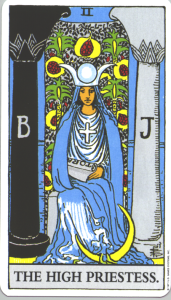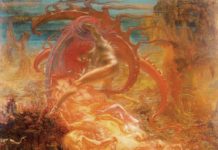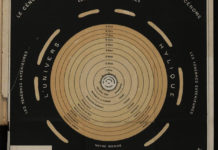A lot of people travelling along the path of the western mysteries delve into Gnosticism, especially students of Martinism and the Rosicrucian Order, after all both contain the Christ mysteries and emphasize importance upon Sophia as our female redeemer. Today you’ll see an interview below, from practicing Gnostic Leslei Kaneel whose writings and insights I really adore, and as well I’ll briefly introduce some thoughts as to whether or not Gnosticism fits with Rosicrucian teachings.
That’s right, I questioned it…
Is Gnosticism really compatible with the Rosicrucian Order?
Many assume that there is a Gnosticism Rosicrucian connection, and I today I am going to make a distinction between the two because this is a Rosicrucian Order blog. Everything here is considered within the context of the Rosicrucian manifestos and those teachings contained therein. If we are to examine them together first we need to find the similarities.
 Both emphasize Christ and Sophia. These two figures are embodied in the human figure of Christian Rosenkreuz who encounters Venus, who is the female manifestation of the same Wisdom redeemer. At the time of the writing of the manifestos many Germans believed in the identity of a female mystery, starting with Jacob Boehme whose teachings streamed into the minds of Rosicrucian followers. Johann Valentine Andrea, author of the Chemical Wedding, shows how Venus appears to C.R.C:
Both emphasize Christ and Sophia. These two figures are embodied in the human figure of Christian Rosenkreuz who encounters Venus, who is the female manifestation of the same Wisdom redeemer. At the time of the writing of the manifestos many Germans believed in the identity of a female mystery, starting with Jacob Boehme whose teachings streamed into the minds of Rosicrucian followers. Johann Valentine Andrea, author of the Chemical Wedding, shows how Venus appears to C.R.C:
“I looked back, and behold it was a fair and glorious lady, whose garments were all sky-coloured, and curiously (like Heaven) bespangled with golden stars; in her right hand she bore a trumpet of beaten gold, on which a Name was engraved which I could well read but am as yet forbidden to reveal it. In her left hand she had a great bundle of letters of all languages, which she (as I afterwards understood) was to carry to all countries. She also had large and beautiful wings, full of eyes throughout, with which she could mount aloft, and fly swifter than any eagle.”
So it would appear that Gnosticism indeed has a lot in common with Rosicrucian cosmology. Looking into greater detail at (some of) the Gnostic scriptures we also encounter the idea that Sophia has fallen, as Sophia Aschamoth. Though no mention of a fallen Sophia occurs in the Rosicrucian model of Boehme, there is a fallen Adam, and there is a hint that Sophia raises herself by redeeming humankind. In the German system we are ourselves broken universal Adam angels, and we may repair ourselves and become one being again, giving birth to the Second Adam, much like Osiris, who is slain and broken, only to be reassembled again. It is Sophia as the Virgin (a mystical shroud of purity) who descends upon the reformed Second Adam human figure, who then covers him, loves him, and allows his Will which is filled with the seed Will of God to impregnate her. Similar to Chinese inner alchemy the mystic becomes ‘pregnant with a psychic embryo,’ which nourishes the sapling of new Christ within, or as Boehme said, we then each ‘become branches in the Vineyard of Christ’ and are born as sons of god.
I do tend to think that where Gnosticism is viewed too often as a cosmology, and somewhat a practice, Jacob Boehme successfully translated that as religious visionary experiences which serve as catalyst towards Regeneration. He constantly insisted that the fall and redemption and birth of Christ were not historical events, but things we have to make happen today, within our own beings. Certainly the real idea behind ‘Gnosis’ is an experience, a beautiful one that the ancient Gnostics sought so dearly to preserve for our present era, which have thankfully survived in the Nag Hammadi scrolls.
The scrolls themselves is one area where I do have one bone to grind with other Rosicrucian Orders, that being the non-existent mention of a general reformation towards incorporating their message officially within the body of Rosicrucian knowledge. The Rosicrucian Order and its doctrine is based upon the three manifestos, the Fama, the Chemical Wedding and the Confession, all published in the early 1600’s. Yet today we have extensively more knowledge than we did in the past, and we have access to more ancient scrolls compared to what the early brotherhoods could get their hands on. This being the case our Rosicrucian Order, the Mystica Aeterna, has considered this and decided; yes we need to regenerate the Rosicrucian mysteries in light of these discoveries and wonderful insights scholars continue to make. As usual it is Jacob Boehme who serves as a bridge between ancient Gnosticism and its later manifestations in Europe.
There is but one caveat to the union between Gnosticism and Rosicrucian thought. The major distinction is that in Gnosticism its adherents viewed Nature as something distasteful, full of temptation, which pulls us down and away from the light. Having been cast out of heaven, Nature, in their view (not all), was actually viewed as a prison, a trap and realm of punishment for original sin. The Rosicrucians on the other hand, influenced by Hermeticism and Paracelsus took a more optimistic view, choosing to see nature as a vehicle of theophany, meaning Nature became a ‘revealer of the word.’
The idea of a theophantic nature implies that God is communicating with us, reaching out to us, through mercy and good grace, through the medium of everything in nature. Birds, leaves, trees, springs, sounds, taste, smells, winds and clouds, are a vehicle of divine communication. This is distinctly different from the ancient Gnostic view, because Rosicrucians started to see nature as their Sophianic experience. Logos or Word, Holy Spirit and the light of Christ in the rays of the sun, live in the fibers of reality.
That is why, in my brief survey I conclude that Gnosticism and Rosicrucian teachings are NOT the same, but rather share personifications and a similar path of regeneration. Any Gnostic can learn something from a Rosicrucian, and any Rosicrucian can learn something from a Gnostic.
That’s why I’m such a big fan of Leslie Kaneel
I decided I had to interview Leslie because her manner of writing is quite striking to say the least. She is a Gnostic teacher and clearly speaks from the heart, and dare I say a higher spirit flows through her messages. You can enjoy her free lessons and insights on her Fanpage here or on the link below at the end of this interview, where she has offered a free lesson. Here were my main questions to Leslie:
What got you into the Gnostic path?
There are many paths that can be termed ‘Gnostic’; being many definitions of what is ‘Gnosis’ from wherever people are at in consciousness. Finding that in my experience there really is not much of a focus on the term Gnostic, as goes for most other terms. The focus from the beginning, so to speak, is always toward indestructible being. And, is mystical knowledge of our indestructible being that set me on the path that is no path.
How would you best summarize the key message of Gnosticism?
Gnosticism is actually a religion formed and forming around the idea of Gnosis. How this happens is that human beings, on this planet, have a great lust to compartmentalize and define things appearing to the senses. A key message is that we experience mystical knowledge, and in such experiences is an entering into consciousness beyond the intellect, where we do not rely on any mental figuring out or conclusions of anything. We may move in any level of consciousness, not isolate to just this or that, but key is that we do not rely on mental grades of consciousness.
Do you have to be Christian to work with the Nag Hammadi scrolls?
No, you don’t have to be Christian; just be yourself J I am not a Christian in the usual, religious sense of this.
How do Gnostic teachings fit into the Rosicrucian phenomena?
Again, there are many and diverse Gnostic teachings and Rosicrucian phenomena is quite a broad subject. Will just say that with Gnostic teachings there are two main categories of dual and non-dual. And, as there are outer and inner orders of Rosicrucian traditions, generally, dual would be outer teachings and non-dual would be inner/secret teachings. True Gnosis, being nothing other than what is enlightenment & liberation, thus, non-dual Gnostic teachings as inner & secret orders of Rosicrucian tradition. The common idea is that an aspirant will sequentially go through the outer, duality, and eventually graduate into the inner, non-duality. This is definitely not always the case, sometimes it is, but mystical knowledge of our indestructible being has no need of a prerequisite…..will leave it at that.
How do we internalize the ideas of the scrolls, into real realizations?
Like any other scriptural writing, the scrolls are a vehicle toward self-realization. As a vehicle, we best not get too attached and absorbed into it, or we’ll never get out, liberated. Thus, to realize scriptural teachings, you must release the teachings and be the teachings. Be what/who the words point to, ultimately in no need of the words. With such an ‘internalization’, we ourselves are the vehicle, Merkavah (Chariot) of self-realization.
What practical methods can we use to attain the goal?
First and foremost is a continuum of meditative practice. Foundation of all is Primordial Meditation; resting in the True Nature of Mind. Our intention in meditation as no goal and no attainment. Realizing that there is no requirement to get somewhere else and that we have everything that we need already. In this way, we cultivate Presence of Awareness in each moment, no matter what the circumstance. In meditative states we are as a lightning rod for Light Transmission…..in other words, deep devotion to the Divine! Divine Presence & Power. Amen.
What is one element of the teaching that most modern seekers tend to miss?
Something very noticeable in modern seekers is the common tendency to intellectualize the teachings. Confusing intellectual information with mystical knowledge. Modern education systems, and systems in general, are heavily laden with emphasis on mental levels of mind. Thus, is often very difficult for people to understand that, for the most part, if not totally, only lower gradations of consciousness are being utilized in daily living. Exiting this loop is a great challenge for many.
Why do you spread the message of these ancient mystics?
I am not spreading the message of anyone but my Self. It’s a direct mystical experience that we authentically speak/act. I will not spread anything that doesn’t flow from such experience. Shalom! J
& Thank You!
And thank you Leslie, your friend on the path, Samuel Robinson J
Free Lesson from Leslie
Contemplation
The ordinary idea of contemplation is to think about something with reason & logic; figuring things out, so to speak. The grossest states of Karmic Vision.
A spiritual practitioner’s idea of contemplation is the study and focusing in on teachings, scriptures, practices, etc. Various gradations in movement of mental consciousness, perhaps even to subtler states of Karmic Vision. Lowest to mid-range direct transmissions of Ruach Ha-Kodesh. Ma’aseh Bereshit – Work of Creation.
In Non-dual Gnostic Awareness, actual Contemplation is continual abiding in the Ever Presence of Pure & Total Consciousness. Conscious Primordial Unity integrated as all manifestation & dissolution of mind. Innermost highest direct transmissions of Ruach Ha-Kodesh. Ma’aseh Merkavah – Work of the Chariot.
Beautifully weaving into dzogchen where Contemplation in the Six Vajra Verses is applied in all Three Precepts of the base, path & fruit. The first two verses are as the Essence of the Base, the next two verses are as the Essence of the Path, and the last two verses are as the Essence of the Fruit. The Six Vajra Verses are part of the dzogchen transmission of Garab Dorje; ancient teachings from Oddiyana later brought into Tibet by Vairochana.
“The nature of phenomena is nondual, but each one, in its own state, is beyond the limits of mind. There is no concept that can define the condition of “what is” but vision nevertheless manifests: all is good.
Everything has already been accomplished, and so, having overcome the sickness of effort, one finds oneself in the self-perfected state: this is Contemplation.”
Amen & Amen! January 5, 2012 ~Leslie Kaneel










